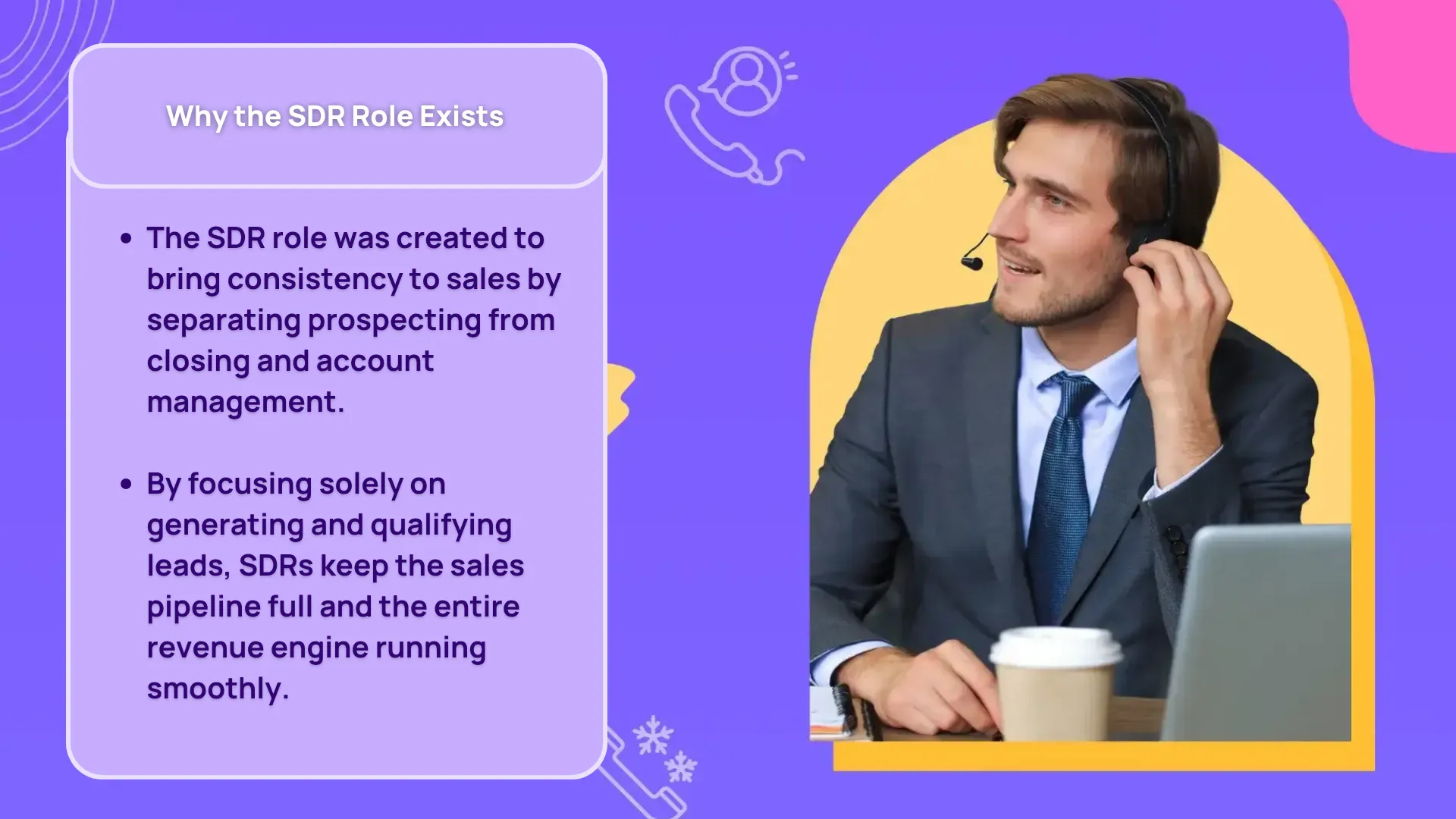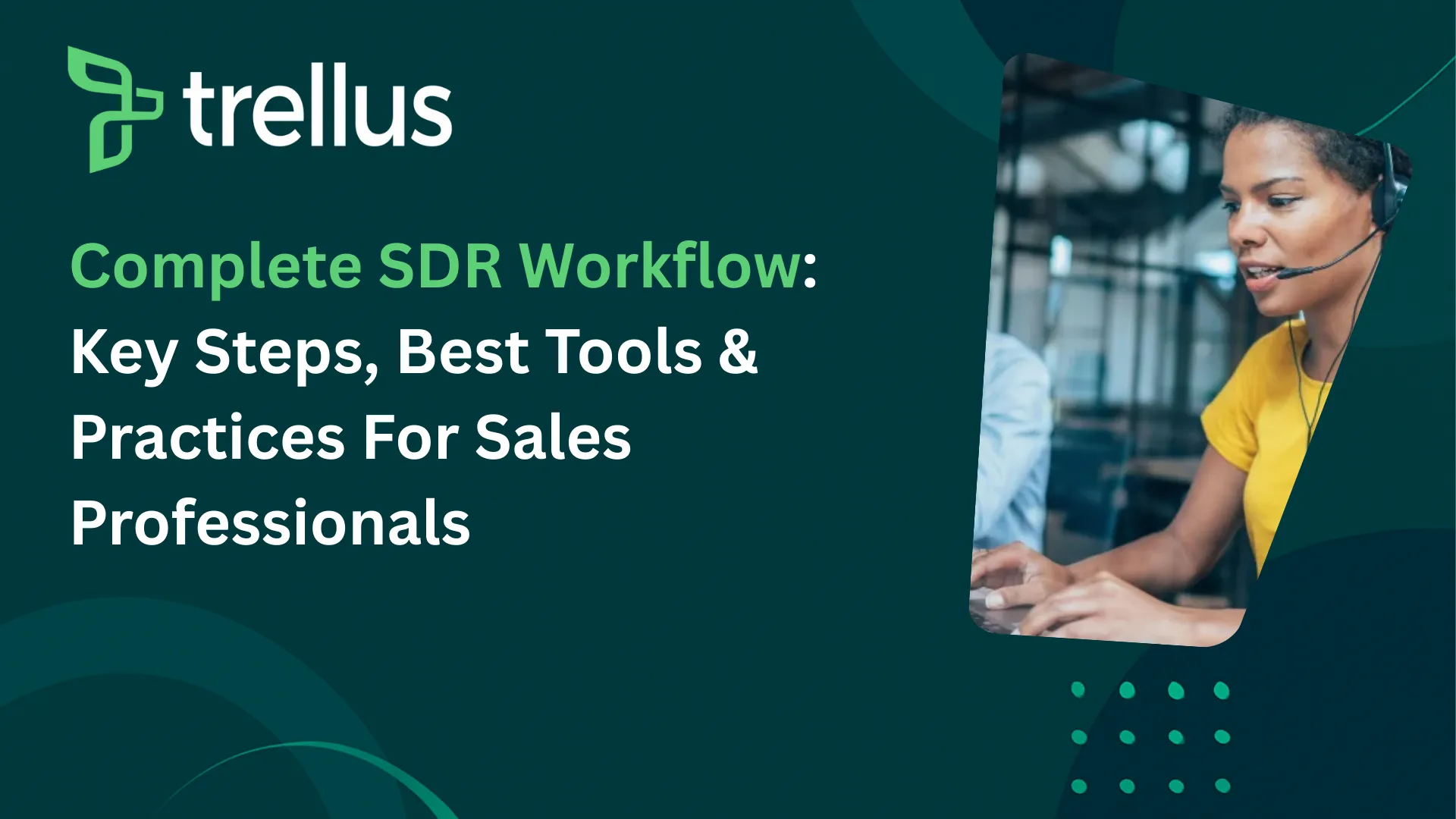
Our Top Picks


Nobody walks into a sales development role as a natural.
Everyone, and I mean everyone, starts out awkward, nervous, and unsure. I was a total mess when I began.
My first few cold calls sounded like I was reading a bad script in a school play. But the thing that separates successful SDRs from those who burn out is simple: they stay curious, learn fast, and get a little bit better every single day.
So if you’re a new SDR reading this, take a breath. You’re not supposed to be perfect. You’re supposed to learn, test, adapt, and figure out what works. The sales world rewards people who learn faster than others.
Why the SDR Role Exists

The SDR function was born out of necessity. Back when companies expected one rep to prospect, close, and manage accounts, sales results were inconsistent. Salesforce famously fixed this with a structure that split reps into three groups: SDRs (prospectors), AEs (closers), and Account Managers (retainers).
When prospecting was handed to a specialized group of SDRs, something magical happened: pipeline consistency. It’s no longer about waiting for “good months” or praying that inbound leads trickle in. SDRs keep the sales engine running.
And that’s exactly what your job is, keeping the sales machine alive.
What SDRs Actually Do Every Day
You’ll live inside your CRM, your sequences, and your call lists. You’ll find new leads, research them, reach out through email and phone, handle rejection gracefully, and keep detailed notes so your Account Executives know who’s worth talking to.
If you do it right, your days will start to feel like well-tuned routines rather than random chaos. Every good SDR eventually builds a rhythm. That rhythm, your daily SDR workflow optimization, is where consistency comes from.
Why People Take Meetings
This one’s crucial. People don’t take meetings because of how polished your pitch sounds. They take meetings because they think it will help them make progress on something they care about. You’re not convincing anyone to buy something. You’re helping them move closer to a goal or away from a pain.
If you ever find yourself frustrated after a hundred calls, remember this: the prospect doesn’t wake up wanting your product. They wake up wanting progress. Your job is to show them how you might help them get there.
A Good Meeting vs. a Bad Meeting
A good SDR call feels like a trailer to a great movie, enough to get the prospect excited, but not so much that you spoil the entire plot.
A bad one feels like reading them the entire movie script before they’ve even bought the ticket.
Keep your message tight, personalized, and relevant. Don’t try to close the deal yourself. Your role is to open the door, not walk through it.
SDR Mindset: The Foundation of Every Great Rep

If you ask ten top SDRs what makes them successful, most won’t say it’s the script, the dialer, or even the product. It’s their mindset.
Sales development is one of those rare jobs where rejection is constant, feedback is instant, and growth is optional. Your ability to handle that cycle will define your career trajectory.
Let’s break down the key principles every new SDR should live by.
SDRs Exist to Find Unmet Needs
If every customer already knew what they needed, your company wouldn’t need you. SDRs exist because markets are messy, people are busy, and solutions often go unnoticed.
When you pick up that phone or send that email, you’re not annoying people. You’re offering them a chance to solve a problem they might not even know exists yet. That’s not an interruption, that’s discovery.
You’re the Frontline of the Business
Think about it, the company’s entire growth depends on what happens in your inbox and on your phone calls. You’re the bridge between opportunity and revenue.
Your work directly fuels the pipeline. Without you, the AEs have nothing to close, marketing has no feedback loop, and product has no idea what problems real customers are facing.
You are the pulse of the business.
Sales is a Microcosm of Entrepreneurship
Being an SDR is the closest you can get to running a business inside someone else’s company. You have a quota instead of revenue goals, tools instead of capital, and prospects instead of customers.
How you plan your days, how you track your numbers, and how you handle failure all mirror what entrepreneurs do. The only difference is that your risk is limited, but your learning potential is unlimited.
Everyone Starts Terrible
No exceptions. The best SDRs I know were once struggling to book one meeting a week. The difference is that they didn’t hide from feedback. They asked for call reviews, compared notes with peers, and made small adjustments every day.
If you can stay curious and consistent, improvement is inevitable.
Best SDR Practices and Habits That You Need To Be Mindful Of
Here’s where things start getting real. SDR success isn’t random; it’s habit-driven. The most consistent performers I’ve worked with all share certain behaviors that make them reliable, predictable, and effective.
1. Organized
Organization isn’t optional in sales development. You’re juggling multiple sequences, dozens of prospects, different time zones, and constant context switching.
The best SDRs treat their calendars like sacred space. They set time blocks for prospecting, calling, emailing, and admin work. They don’t let interruptions dictate their day.
A few practical steps:
- Block your mornings for hard tasks, prospect research, and outbound calls. That’s when your energy and focus are highest.
- Use your CRM properly. Update notes, mark stages, and tag accounts regularly. CRM adoption best practices aren’t about keeping management happy; they’re about keeping your pipeline healthy.
- Review your call list by region or time zone. Hitting East Coast executives at 4 PM their time is a waste of effort.
Why it matters:
Being organized means you create consistency. And in sales development, consistency drives results. When your calendar, CRM, and follow-ups are clean, you can focus entirely on your pitch instead of worrying about who to call next.
2. Proactive
A top-performing SDR never waits to be handed a list. They find new leads, track buying signals, and hunt for opportunities before anyone else.
This is where sales enablement content strategy meets curiosity. Great SDRs use content, from case studies to webinars, to identify active buyers. They know that every new signal is a chance to start a conversation before competitors do.
Proactive habits include:
- Checking LinkedIn and company news for hiring signals, funding announcements, or leadership changes. These are strong buying triggers.
- Personalizing messages based on those triggers instead of relying on generic templates.
- Reviewing analytics inside your CRM to understand which channels and cadences perform best.
This habit ties directly to performance tracking for SDRs. The best reps don’t just know how many calls they made, they know which types of calls, messages, and timing led to meetings.
3. Growth-Oriented
Top SDRs are obsessed with progress, not perfection. They study sales calls like athletes watch game tapes. They consume podcasts, read LinkedIn posts, and take notes from their peers.
A growth mindset isn’t about motivation quotes. It’s about pattern recognition. You’ll start seeing what works for you, what doesn’t, and how to adjust faster than others.
One powerful way to stay in this mindset is through daily SDR workflow optimization, reviewing your previous day’s activity, noting what drove responses, and refining your sequences every week.
If you treat each day as an experiment, your skill curve will rise faster than you expect.
4. SDRs Need To Be Teachable
There’s nothing worse than a “know-it-all” SDR.
The truth is, even veterans learn something new every month. Being teachable means taking feedback without defensiveness and being curious enough to apply it.
Make time to review your own calls. Listen to how you handle objections. Are you rushing? Talking over prospects? Missing buying signals? These small tweaks multiply your success rate over time.
Role-plays are another underrated tool. The tougher your team’s mock calls are, the smoother your real calls will feel. The best SDRs don’t wait for coaching; they ask for it.
5. Treat Your First 90 Days Like an On-Ramp, Not a Sprint
Most new SDRs burn out fast because they try to crush it too early. They overanalyze metrics, get obsessed with daily quotas, and panic when things don’t convert.
Here’s what I tell new reps:
“Your first 90 days aren’t about closing meetings. They’re about building confidence and learning the craft.”
You’re building the foundation for long-term success. Spend your first three months:
- Learning how to use your tools (CRM, dialer, sequencing platform).
- Listening to top reps’ calls every day.
- Practicing your opener and discovery questions out loud.
- Setting small, achievable goals (e.g., 10 connects a day, 2 learning takeaways per call block).
Success compounds. You’ll notice that the SDRs who hit their quota consistently six months in are the ones who used their first 90 days to master the basics instead of chasing shortcuts.
6. Organize Your Workflow Like a Pro
Chaos kills productivity.
A common mistake I see new SDRs make is waking up, opening their CRM, and then “figuring it out.” That’s a losing formula.
Top SDRs plan before they prospect. They know:
- Who they’re calling
- Why they’re calling
- What their goal is
Here’s my simple daily structure that kept me consistent:
Morning (8–10 AM): Prep & Research
- Review your target list for the day.
- Research key accounts and decision-makers.
- Personalize your sequences and notes.
Midday (10 AM–1 PM): Call Blitz
- Focus purely on outbound, no distractions.
- Use an embedded parallel dialer like Trellus to maximize talk time.
- Keep a tally of conversations (not just dials).
Afternoon (2–5 PM): Follow-Up & Reflection
- Send follow-ups and personalized Looms.
- Log notes properly in the CRM.
- Review what worked and what didn’t.
The more structure you have, the less mental fatigue you experience. An organization gives you freedom; it allows you to think strategically instead of reactively.
7. Be Relentlessly Curious About Your ICP
If you don’t understand who you’re calling, everything else falls apart.
Your ICP (Ideal Customer Profile) isn’t just a list of job titles; it’s a set of people with goals, pressures, and language.
Before every call block, I’d ask myself:
“If I were in their shoes, why would I take a meeting with me?”
Study your ICP’s:
- Daily pains: What’s frustrating them at work?
- KPIs: What are they measured on?
- Language: What phrases do they use on LinkedIn or in interviews?
Example: if you’re selling a dialer to SDR managers, don’t just say, “We help you make more calls.” Instead, try:
“I know a lot of SDR leaders struggle with reps wasting time between dials or missing connect windows. We solve that by automatically connecting reps to live prospects with local presence.”
That phrasing shows empathy, understanding, and relevance, three ingredients that make people listen.
8. Listen to Your Own Calls
The fastest way to improve is to listen to yourself.
No one enjoys hearing their own voice, but that’s where real progress happens.
After each day, I’d listen to two or three of my own calls and ask:
- How was my tone in the opener?
- Did I sound rushed or confident?
- Where did I lose control of the call?
- What objections caught me off guard?
Over time, you’ll start recognizing patterns, the moments where prospects disengage or lean in. Once you know those moments, you can control them.
Bonus tip: Pair up with another SDR and review each other’s calls. You’ll catch blind spots that you never notice yourself.
9. Focus on Quality Conversations, Not Just Activity Metrics
There’s a myth that “more dials = more meetings.” That’s only half true.
Activity matters, but it’s intentional activity that wins.
You could make 200 dials a day and get nowhere if your list is bad, your opener is weak, and your follow-up is lazy. On the other hand, 60 highly targeted calls with research and personalization can crush it.
The best SDRs know how to balance volume and quality. They focus on conversion metrics, not vanity metrics.
Here’s what you should measure weekly:
- Connect rate (Are you reaching live people?)
- Meeting booked rate (How many connects turn into meetings?)
- Show rate (Are meetings actually happening?)
Optimize your process based on these, not just the total number of calls.
10. Personalize at Scale (Without Burning Hours)
Every SDR gets told “personalize your outreach,” but few understand how much personalization is enough, or how to do it efficiently.
Here’s the truth: you don’t need to write a love letter for every prospect. You just need to show that you’ve done your homework and that you’re not a bot.
Top SDRs use a three-layer personalization framework:
Layer 1: Relevance (Always)
Tailor your outreach based on why this prospect should care now.
Example:
“I noticed your team recently scaled headcount. Often, when that happens, call volumes and data accuracy issues spike. We help SDR teams handle that scaling curve smoothly.”
This shows you understand a business context, not just the person’s title.
Layer 2: Resonance (When Possible)
Connect to something personal, like a quote, a podcast, a LinkedIn post, or a shared challenge.
Example:
“I saw your post about how your team hit record connect rates last quarter, congrats! Curious if that’s driven more by better data or improved dialer tech?”
You’re creating a mutual conversation, not a cold pitch.
Layer 3: Repeatable Frameworks
Use templates and snippets to make personalization efficient:
- Save 3–5 “persona-based” openers for each ICP.
- Automate insertion fields with your sequencing tool.
- Batch similar personas so you can write once, adapt fast.
The goal is authentic scalability, not generic automation.
Personalization is like seasoning: too little and it’s bland; too much and it feels forced. The right balance is when the message feels tailored just enough to make them stop scrolling.
11. Lead with Insight, Not a Pitch
One of the biggest rookie mistakes I see is SDRs jumping straight into “We do X for companies like you.”
That’s not a hook, that’s a résumé.
The best SDRs lead with curiosity and insight. They make the prospect think, “That’s interesting, tell me more.”
Here’s the formula I use for opening lines in cold calls or emails:
“A lot of [prospect role] I speak with are struggling with [specific pain]. Out of curiosity, how are you handling that right now?”
Or in email form:
“I noticed many [industry] teams are seeing [trend]. Are you also noticing that, or have you already solved it?”
This approach does three things at once:
- It shows you understand their world.
- It starts a two-way conversation (not a monologue).
- It positions you as a peer, not a peddler.
You’re not “selling”; you’re diagnosing. And people buy from those who help them think differently about their problems.
12. Build an Objection Handling Playbook
If there’s one skill that defines top SDRs, it’s how they handle “no.”
Rejection isn’t personal, it’s data. Every objection gives you clues about timing, relevance, or perceived value.
Start building your personal objection playbook. For each common objection, write down:
- What it really means.
- A question or reframe to keep the conversation alive.
Let’s look at examples:
“We’re not looking right now.”
“Totally fair, most teams I speak with aren’t actively looking until something breaks. Out of curiosity, what’s working well for you right now?”
“Send me some info.”
“Happy to. Just so I send the right stuff, what specifically caught your interest, efficiency, call connect rates, or reporting?”
“We already have a solution.”
“Got it, a lot of the teams we work with did too before realizing their reps were losing hours to call latency. What are you using currently?”
The goal isn’t to “overcome” objections; it’s to stay in the conversation long enough to uncover the truth.
And when you hear the same objection three or more times, don’t just update your script, update your process. Maybe your targeting is off, or your timing is wrong.
13. Master Your CRM and Tech Stack
The SDRs who progress fastest are the ones who treat their tools like extensions of their brain.
It’s not glamorous, but it’s critical. You can’t scale what you can’t measure.
Here’s your minimum stack mastery checklist:
- CRM (HubSpot, Salesforce): Know how to log notes efficiently, set reminders, and track stages.
- Dialer (e.g., Trellus, Orum, Aircall): Learn shortcuts, call logging, and local presence features.
- Sequencing Tools (Outreach, Apollo, Salesloft): Automate follow-ups without losing personalization.
- Data Tools (ZoomInfo, Clay, Lusha): Verify contacts and enrich data before calling.
Master your tools. They’ll make you faster, sharper, and more valuable.







